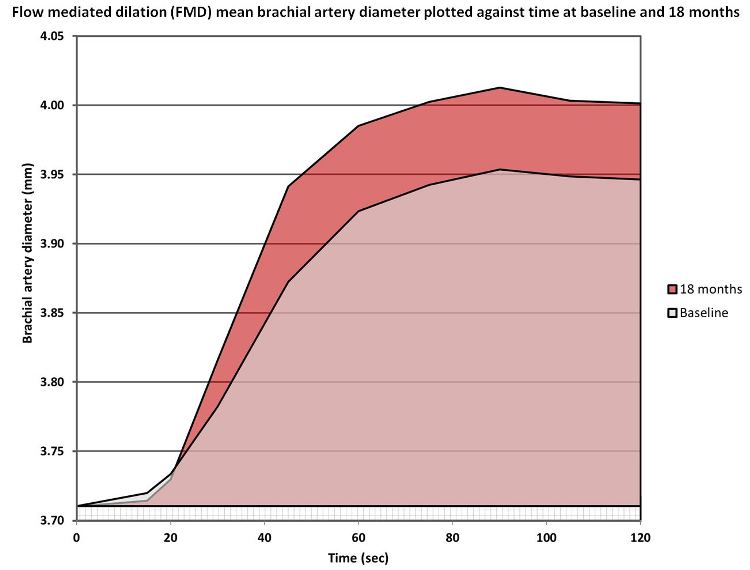Session Information
Date: Sunday, November 8, 2015
Title: Rheumatoid Arthritis - Small Molecules, Biologics and Gene Therapy Poster I
Session Type: ACR Poster Session A
Session Time: 9:00AM-11:00AM
Background/Purpose: Endothelial dysfunction is an early step in the formation of atherosclerotic lesions and can be quantified by the degree of flow mediated vasodilation (FMD) of the brachial artery. FMD is a predictor of cardiovascular (CV) events in the general population and is lower in patients with inflammatory joint diseases (IJD) compared to the general population. Restoration of endothelial function to normal levels has been proposed as an important factor in the process of atherosclerotic plaque regression. Our aim was to investigate the effect of long-term rosuvastatin therapy on FMD in patients with IJD and carotid artery plaque(s) (CP). Furthermore, we evaluated associations between change in FMD (ΔFMD) and change in CP height, arterial stiffness [aortic pulse wave velocity (aPWV) and augmentation index (AIx)], lipids, rheumatic disease activity and inflammatory variables.
Methods: Eighty-five statin naïve patients with IJD and ultrasound verified CP (rheumatoid arthritis: 53, ankylosing spondylitis: 24, psoriatic arthritis: 8) received rosuvastatin treatment for 18 months to obtain low density lipoprotein cholesterol goal <1.8 mmol/L. All patients underwent assessment of FMD, aPWV, AIx and carotid ultrasound at baseline and at study end. Change in FMD from baseline to study end was analyzed using paired-samples t-test. Furthermore, multiple linear regression analyses, adjusted for age, gender and use of biologic disease-modifying anti-rheumatic drugs, were applied to evaluate associations between DFMD and change in CP height, aPWV, AIx, lipids, disease activity/inflammatory variables and medication. In addition, the mean diameter of the brachial artery as a result of FMD was plotted against time at baseline and 18 months.
Results: The patient cohort had 60% females and the median (IQR) age and disease duration was 61.0 (56.0-67.0) and 18.0 (8.3-26.0) years, respectively. The mean ±SD FMD was significantly improved from 7.10 ±3.14 % at baseline to 8.70 ±2.98 % at study end (p<0.001). Multiple linear regression analyses revealed that the FMD improvement was linearly associated with the improvement in arterial stiffness as measured by AIx: β (CI): -0.09 (-0.18, 0.00) (p=0.05) and CP height regression: β (CI): -3.10 (-4.95, -1.25) (p=0.001). DFMD was not associated with changes in lipid levels, disease activity, inflammatory variables or medication. The mean diameter of the brachial artery as a result of FMD was plotted against time at baseline and 18 months is shown in figure.
Conclusion: Long-term lipid lowering with rosuvastatin improved endothelial function measured by FMD in IJD patients with atherosclerotic disease. The statin-induced improvement in endothelial function was linearly associated with reduced arterial stiffness and CP regression. Our results support the hypothesis that restoration of endothelial function plays an important role in the process of atherosclerotic regression.
To cite this abstract in AMA style:
Ikdahl E, Hisdal J, Rollefstad S, Olsen IC, Kvien TK, Pedersen TR, Semb AG. Rosuvastatin Improves Endothelial Function in Patients with Inflammatory Joint Diseases, Longitudinal Associations with Atherosclerosis and Arteriosclerosis [abstract]. Arthritis Rheumatol. 2015; 67 (suppl 10). https://acrabstracts.org/abstract/rosuvastatin-improves-endothelial-function-in-patients-with-inflammatory-joint-diseases-longitudinal-associations-with-atherosclerosis-and-arteriosclerosis/. Accessed .« Back to 2015 ACR/ARHP Annual Meeting
ACR Meeting Abstracts - https://acrabstracts.org/abstract/rosuvastatin-improves-endothelial-function-in-patients-with-inflammatory-joint-diseases-longitudinal-associations-with-atherosclerosis-and-arteriosclerosis/

